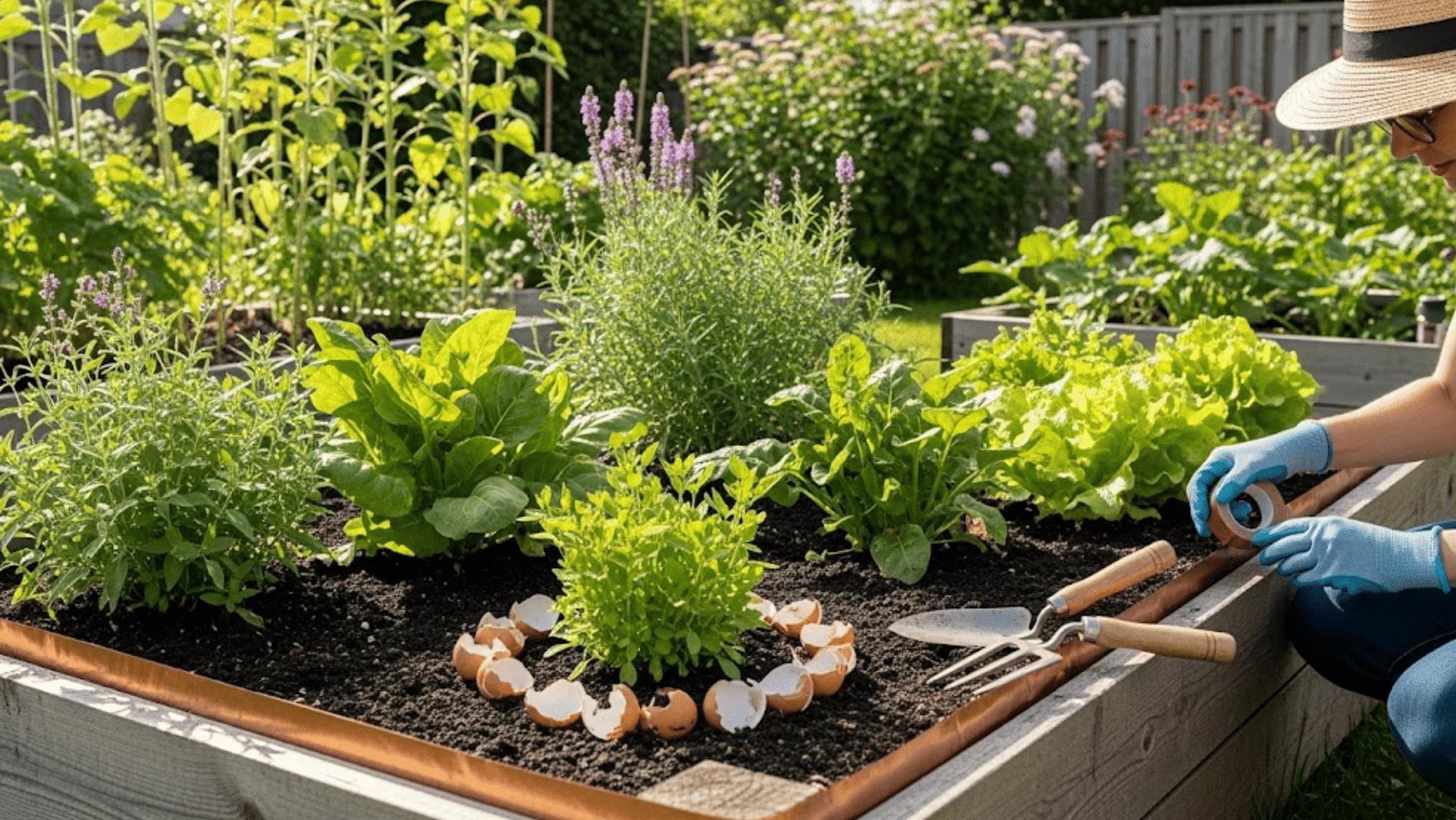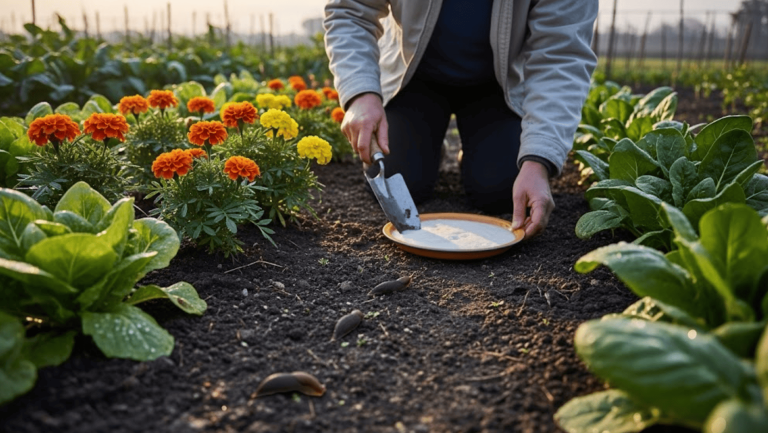Sick of waking up to slime trails and chewed-up plants? Same struggle here. Few things are more frustrating than finding your favorite seedlings shredded overnight by slugs. These pests don’t just nibble, they wipe out entire plants before breakfast.
The good news? You don’t need fancy sprays or toxic pellets to fight back. Most of what you need is already in your garage or kitchen.
With the right techniques and a little consistency, you can keep slugs in check without wrecking your soil or risking your pets.
Some methods work fast. Others take a little time. But when you mix them right, you’ll stop the damage for good. Let’s walk through the real, practical slug control tricks that actually work.
Why Slugs Invade Gardens
Slugs show up in gardens for three main reasons: moisture, food, and shelter. They need damp conditions to survive, so things like morning dew, frequent watering, or humid weather work in their favor.
Thick mulch, fallen leaves, and dense plant beds give them the perfect places to hide during the day. They’re especially drawn to tender seedlings and soft leaves; lettuce, hostas, and young flowers are all favorites.
You’ll notice more slug activity in spring and fall when the weather stays cool. During hot afternoons, they hide out and wait for nightfall to do their damage.
Watch for shiny slime trails and uneven holes in leaves; both are classic signs that slugs have moved in. Understanding these patterns is the first step in learning how to get rid of slugs in garden spaces effectively.
Effective Ways to Keep Slugs Out of the Garden

I’ve learned over the years that keeping slugs out takes a mix of approaches. Barriers, traps, and natural predators all have their place. Some give quick results, others take a little patience.
1. Use Copper Tape Around Pots or Garden Beds
Copper tape sends slugs packing with a tiny electric zap when they try to cross. Wrap it around pots, raised beds, or any surface they crawl up. Just make sure the loop is solid, no gaps.
Wipe surfaces clean before sticking it down. Over time, grime weakens it, so replace it when needed. It’s simple, clean, and works without harming your plants or soil.
2. Scatter Crushed Eggshells Around Plants
Crushed eggshells aren’t just kitchen scraps; they’re a great slug barrier. Dry them out, crush them up, and sprinkle them around your plants. The jagged edges make slugs think twice.
Keep the ring thick and wide. It’s not a forever fix; rain flattens the edge, so reapply after storms. Bonus: As they break down, eggshells add calcium back into your soil. Double win.
3. Apply Diatomaceous Earth to the Soil Surface
This dusty stuff looks harmless, but it’s brutal on slugs. Diatomaceous earth dries out their soft bodies fast. Dust it lightly around your plants. Wear a mask, it’s powdery. It works best dry, so reapply after rain.
Safe for pets and people, but tough on soft-bodied pests. You’re not poisoning anything, just making life rough for the slimy ones.
4. Surround Plants with Gritty Sand or Crushed Gravel
Slugs aren’t fans of rough travel. A two-inch strip of coarse sand or crushed gravel around your plants acts like barbed wire. It scrapes and irritates, and they’ll steer clear. Sharp gravel works best; smooth stuff doesn’t do much.
Keep the barrier tidy and topped off, especially after a good rain. Bonus: you’ll improve drainage and reduce weeds while you’re at it.
5. Use Wool Pellets or Wool Mats as a Barrier
Wool’s a triple threat: it absorbs moisture, irritates slugs, and even feeds the soil over time. Lightly dampen the pellets and spread them around your plants. Or use wool mats, they both block slug traffic and discourage nighttime visits.
They’ll break down eventually, especially when it rains, so keep them fresh. It’s clean, effective, and kind to your garden soil.
6. Handpick Slugs at Night with a Flashlight
Sometimes you’ve just gotta roll up your sleeves. Head out after dark with a flashlight and a bucket of soapy water. Slugs are most active then, and you’ll spot them around plant bases and mulch.
Use gloves or tweezers and drop them in the bucket. It’s not glamorous, but it works. No chemicals, no mystery; just boots-on-the-ground slug control that gives you real results.
7. Improve Drainage by Adding Compost or Coarse Sand
Slugs grow in soggy soil. Mix compost or coarse sand into garden beds to boost drainage. Water moves through faster, the top layer dries quicker, and slugs are less interested.
Raised beds and containers with good drainage help too. This doesn’t just deter slugs, it gives your plants stronger roots and fewer disease problems. Healthy soil always beats a wet slug haven.
8. Keep Mulch Layers Thin and Dry
Too much mulch is a slug’s dream home. Keep it thin, no more than two inches, and let it dry out between waterings. Use straw, bark, or shredded leaves in moderation.
If mulch stays wet or you see slug signs, pull it back temporarily. Slugs hide under the surface during the day, so stay a step ahead and check under there regularly.
9. Prune Dense Foliage Near the Ground
Slugs hide under low, thick leaves during the day. Prune those bottom branches so air and sun can dry the soil underneath. Keep stems off the ground and open things up.
This discourages slugs and gives you a better look at what’s going on. Healthy airflow helps prevent other pests and diseases, too. It’s low effort, high reward.
10. Keep Grass and Weeds Trimmed Around Planting Areas
Tall grass and weeds near your garden are slug hotels. Mow, trim, or hoe them down around the edges and pathways. Don’t leave the clippings, they’ll just hold more moisture.
Keeping things tidy reduces hiding places and cuts down on damage overnight. Think of it as a clean perimeter; it makes it harder for slugs to sneak in and do their damage.
11. Attract Frogs and Toads with a Shallow Water Source
Want a natural slug patrol? Bring in frogs and toads. A shallow dish of water tucked into a shady garden corner does the trick. Add a rock or ramp so they can climb in and out.
Surround the area with stones or groundcover for shelter. If they feel safe, they’ll stick around, and trust me, they’ll earn their keep snacking on slugs.
12. Release Nematodes into the Soil
These microscopic heroes work underground, hunting slugs where they hide. Mix nematodes with water and apply to moist soil in the evening or on a cloudy day. They need warmth and moisture, so plan it right.
Safe for kids, pets, and plants, no chemicals involved. Reapply every few weeks during peak slug season. It’s a smart, hands-off way to fight back from the root level.
13. Plant Strong-Scented Herbs Like Thyme or Garlic
Slugs can’t stand strong smells. Herbs like thyme, garlic, rosemary, and sage double as pest control and flavor boosters. Plant them between veggies or flowers to act as a natural barrier.
They’re easy to grow, low-maintenance, and look good doing it. Crush a few leaves now and then to release more scent, it helps keep those slimy grazers at bay, the simple way.
14. Use Marigolds or Lettuce as Sacrificial Decoy Plants
Sometimes it’s smart to let slugs have a snack, just not your prize plants. Put out a patch of marigolds or lettuce on the garden edge. Slugs go for them first.
Come out in the morning and scoop ‘em up. It won’t solve everything, but it keeps damage predictable and manageable. Think of it as bait that protects the rest of your garden.
15. Install Bird Feeders or Birdbaths to Attract Birds
Robins, thrashers, and blackbirds aren’t just fun to watch; they’re slug hunters, too. Hang a bird feeder or set up a clean birdbath near your garden beds. Birds will come for the snacks and stick around for the pests.
Skip the chemical slug killers, they’re bad news for birds. Once they find your yard, they’ll help with slug control and bring a little life to your landscape.
16. Set Up Beer Traps at Soil Level
Beer traps work because slugs love yeast. Bury a shallow container of beer so the rim sits flush with the soil. Slugs crawl in for a sip and drown. Clean and refill every few days, especially after rain.
Keep traps away from your best plants, or you might draw in more trouble. Use them smartly, and they’ll thin the herd without much effort.
17. Place Halved Citrus Fruits Upside-Down Overnight
Slugs can’t resist the sweet moisture inside citrus rinds. Slice an orange or grapefruit in half and place the peel face down in the garden. Overnight, slugs crawl in to hide. In the morning, lift and toss them out.
Repeat with fresh citrus halves every couple of days. It’s an easy, chemical-free trick that makes slug removal feel a little more satisfying.
18. Use Raw Potato Slices as Slug Bait
Here’s an old-school trap that works great. Cut raw potatoes into thick slices and lay them cut-side down near your plants. Slugs head for the cool, moist underside and settle in.
Check under the slices early in the morning, collect the slugs, and compost or toss the used potato. It’s simple, cheap, and surprisingly effective. You probably already have everything you need in your kitchen.
19. Invert Clay Pots with Straw to Lure Hiding Slugs
Turn a small clay pot upside-down with a bit of straw or damp newspaper inside. Prop up one side slightly to let slugs crawl in overnight. By morning, they’re tucked in, making them easy to collect.
These traps blend into garden beds and work night after night. Rinse and refresh them as needed to keep the slug count down without chemicals or hassle.
Avoid These Slug-Related Blunders Next Time
I see many gardeners fighting slugs while unknowingly rolling out the welcome mat. Here are the most common slip-ups:
- Watering late in the day: Evening watering keeps soil damp all night, which is exactly what slugs love most.
- Leaving thick, wet mulch everywhere: Soggy mulch becomes a cozy slug hotel where they hide and breed happily.
- Using toxic slug pellets near pets: Chemical baits can poison dogs, cats, and helpful wildlife that eat the slugs.
- Forgetting about garden edges and corners: Shady, overgrown spots along fences give slugs perfect hiding places during the day.
Avoid these mistakes, and your slug control routine will start working a whole lot faster.
Wrapping Up
You don’t need fancy products or a pest control degree to keep slugs out of your garden. With a few smart, natural strategies, you’ve now got a solid toolkit that works.
I’ve watched these exact methods turn slug-ridden beds into healthy, booming garden spaces, and they’ll work for you too.
Start small. Try one or two tricks, then build from there. Stay consistent, adjust as needed, and let nature do the heavy lifting. Your plants will bounce back, your mornings will be slug-free, and your pets will stay safe the whole way through.
Got a favorite slug-fighting tip or success story? Drop it in the comments, I’d love to hear what’s worked in your backyard.













